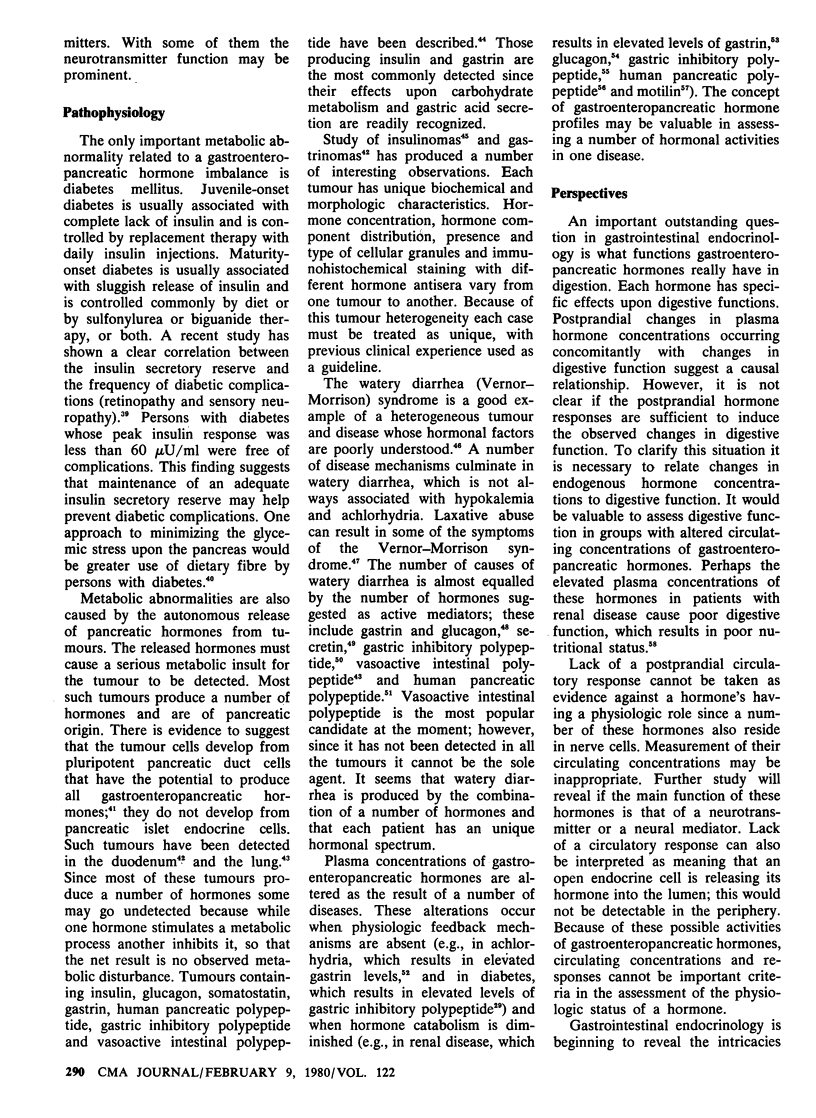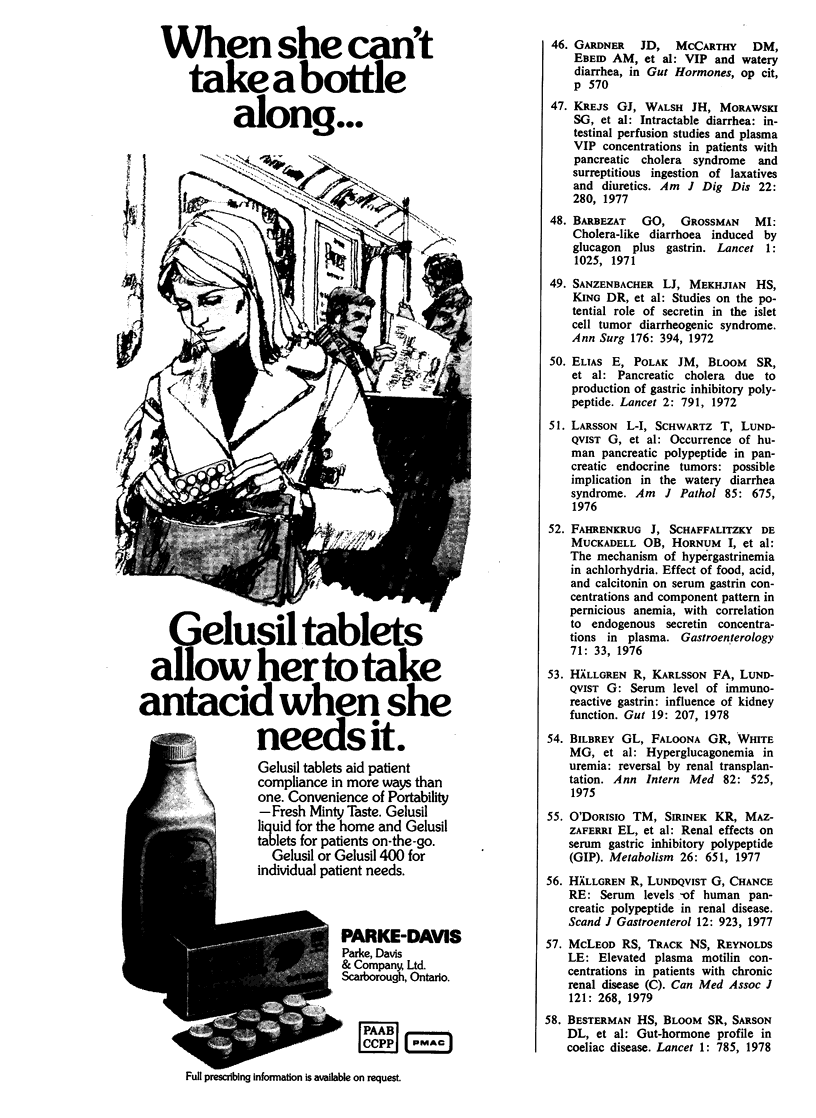Abstract
Gastrointestinal endocrinology is the study of the hormonal regulation of digestion. A number of characterized polypeptide hormones have been localized in specific gastroenteropancreatic endocrine cells. The fact that some of these hormones are also found in nerve and brain cells has given rise to the concept of a gut-brain axis. The functional capacities of these endocrine cells are determined by their anatomic location; the luminal exposure of gastroenteric endocrine cells represents an additional avenue for stimulation and release that is not open to pancreatic endocrine cells. Gastroenteropancreatic hormones regulate carbohydrate metabolism, gastric acid secretion, pancreatic exocrine and gallbladder function, gastrointestinal motility and blood flow. These important regulatory hormones may in turn be controlled by a series of gastroduodenal releasing hormones.
Diabetes mellitus is the most important metabolic disorder related to a gastroenteropancreatic hormone imbalance. Most tumours producing these hormones are of pancreatic origin and produce a number of hormones; insulinomas and gastrinomas are detected readily because of the serious metabolic distrubances they cause. Other instances of altered circulating concentrations of these hormones result from rather than cause the disease.
The challenge of future study is to determine if postprandial changes in the plasma concentrations of these hormones are sufficient or necessary, or both, for the control of digestion.
Full text
PDF





Selected References
These references are in PubMed. This may not be the complete list of references from this article.
- Adelson J. W., Rothman S. S. Candidate hormones of the gut. II. Chymodenin. Gastroenterology. 1974 Oct;67(4):731–733. [PubMed] [Google Scholar]
- Barbezat G. O., Grossman M. I. Cholera-like diarrhoea induced by glucagon plus gastrin. Lancet. 1971 May 15;1(7707):1025–1026. doi: 10.1016/s0140-6736(71)91428-0. [DOI] [PubMed] [Google Scholar]
- Besterman H. S., Bloom S. R., Sarson D. L., Blackburn A. M., Johnston D. I., Patel H. R., Stewart J. S., Modigliani R., Guerin S., Mallinson C. N. Gut-hormone profile in coeliac disease. Lancet. 1978 Apr 15;1(8068):785–788. doi: 10.1016/s0140-6736(78)92994-x. [DOI] [PubMed] [Google Scholar]
- Bilbrey G. L., Faloona G. R., White M. G., Atkins C., Hull A. R., Knochel J. P. Hyperglucagonemia in uremia: reversal by renal transplantation. Ann Intern Med. 1975 Apr;82(4):525–528. doi: 10.7326/0003-4819-82-4-525. [DOI] [PubMed] [Google Scholar]
- Bryant M. G., Polak M. M., Modlin I., Bloom S. R., Albuquerque R. H., Pearse A. G. Possible dual role for vasoactive intestinal peptide as gastrointestinal hormone and neurotransmitter substance. Lancet. 1976 May 8;1(7967):991–993. doi: 10.1016/s0140-6736(76)91863-8. [DOI] [PubMed] [Google Scholar]
- Carr-Locke D. L., Track N. S. Human pancreatic polypeptide in pancreatic juice. Lancet. 1979 Jan 20;1(8108):151–152. doi: 10.1016/s0140-6736(79)90538-5. [DOI] [PubMed] [Google Scholar]
- Creutzfeldt M. Candidate hormones of the gut. XV. Insulin-releasing factors of the gastrointestinal mucosa (Incretin). Gastroenterology. 1974 Oct;67(4):748–750. [PubMed] [Google Scholar]
- Creutzfeldt W., Arnold R., Creutzfeldt C., Deuticke U., Frerichs H., Track N. S. Biochemical and morphological investigations of 30 human insulinomas. Correlation between the tumour content of insulin and proinsulin-like components and the histological and ultrastructural appearance. Diabetologia. 1973 Jun;9(3):217–231. doi: 10.1007/BF01219786. [DOI] [PubMed] [Google Scholar]
- Creutzfeldt W., Arnold R., Creutzfeldt C., Track N. S. Mucosal gastrin concentration, molecular forms of gastrin, number and ultrastructure of G-cells in patients with duodenal ulcer. Gut. 1976 Oct;17(10):745–754. doi: 10.1136/gut.17.10.745. [DOI] [PMC free article] [PubMed] [Google Scholar]
- Creutzfeldt W., Arnold R., Creutzfeldt C., Track N. S. Pathomorphologic, biochemical, and diagnostic aspects of gastrinomas (Zollinger-Ellison syndrome). Hum Pathol. 1975 Jan;6(1):47–76. doi: 10.1016/s0046-8177(75)80109-2. [DOI] [PubMed] [Google Scholar]
- Creutzfeldt W. Pancreatic endocrine tumors--the riddle or their origin and hormone secretion. Isr J Med Sci. 1975 Jul;11(7):762–776. [PubMed] [Google Scholar]
- Dockray G. J. Comparative biochemistry and physiology of gut hormones. Annu Rev Physiol. 1979;41:83–95. doi: 10.1146/annurev.ph.41.030179.000503. [DOI] [PubMed] [Google Scholar]
- Domschke W. Motilin: spectrum and mode of gastrointestinal actions. Am J Dig Dis. 1977 May;22(5):454–491. doi: 10.1007/BF01071895. [DOI] [PubMed] [Google Scholar]
- Elias E., Polak J. M., Bloom S. R., Pearse A. G., Welbourn R. B., Booth C. C., Kuzio M., Brown J. C. Pancreatic cholera due to production of gastric inhibitory polypeptide. Lancet. 1972 Oct 14;2(7781):791–793. doi: 10.1016/s0140-6736(72)92148-4. [DOI] [PubMed] [Google Scholar]
- Fiddian-Green R. G., Farrell J., Havlichek D., Jr, Kothary P., Pittenger G. A physiological role for luminal gastrin? Surgery. 1978 Jun;83(6):663–668. [PubMed] [Google Scholar]
- Fontaine J., Le Douarin N. M. Analysis of endoderm formation in the avian blastoderm by the use of quail-chick chimaeras. The problem of the neurectodermal origin of the cells of the APUD series. J Embryol Exp Morphol. 1977 Oct;41:209–222. [PubMed] [Google Scholar]
- Goulder T. J., Alberti K. G. Dietary fibre and diabetes. Diabetologia. 1978 Oct;15(4):285–287. doi: 10.1007/BF02573820. [DOI] [PubMed] [Google Scholar]
- Greenberg G. R., McCloy R. F., Adrian T. E., Chadwick V. S., Baron J. H., Bloom S. R. Inhibition of pancreas and gallbladder by pancreatic polypeptide. Lancet. 1978 Dec 16;2(8103):1280–1282. doi: 10.1016/s0140-6736(78)92042-1. [DOI] [PubMed] [Google Scholar]
- Hällgren R., Karlsson F. A., Lundqvist G. Serum level of immunoreactive gastrin: influence of kidney function. Gut. 1978 Mar;19(3):207–213. doi: 10.1136/gut.19.3.207. [DOI] [PMC free article] [PubMed] [Google Scholar]
- Hällgren R., Lundqvist G., Chance R. E. Serum levels of human pancreatic polypeptide in renal disease. Scand J Gastroenterol. 1977;12(8):923–927. doi: 10.3109/00365527709181351. [DOI] [PubMed] [Google Scholar]
- Krejs G. J., Walsh J. H., Morawski S. G., Fordtran J. S. Intractable diarrhea. Intestinal perfusion studies and plasma VIP concentrations in patients with pancreatic cholera syndrome and surreptitious ingestion of laxatives and diuretics. Am J Dig Dis. 1977 Apr;22(4):280–292. doi: 10.1007/BF01072184. [DOI] [PubMed] [Google Scholar]
- Larsson L-I Corticotropin-like peptides in central nerves and in endocrine cells of gut and pancreas. Lancet. 1977 Dec 24;2(8052-8053):1321–1323. doi: 10.1016/s0140-6736(77)90368-3. [DOI] [PubMed] [Google Scholar]
- Larsson L. I., Schwartz T., Lundqvist G., Chance R. E., Sundler F., Rehfeld J. F., Grimelius L., Fahrenkrug J., Schaffalitzky de Muckadell O., Moon N. Occurrence of human pancreatic polypeptide in pancreatic endocrine tumors. Possible implication in the watery diarrhea syndrome. Am J Pathol. 1976 Dec;85(3):675–684. [PMC free article] [PubMed] [Google Scholar]
- Martino E., Lernmark A., Seo H., Steiner D. F., Refetoff S. High concentration of thyrotropin-releasing hormone in pancreatic islets. Proc Natl Acad Sci U S A. 1978 Sep;75(9):4265–4267. doi: 10.1073/pnas.75.9.4265. [DOI] [PMC free article] [PubMed] [Google Scholar]
- Matsuyama T., Foà P. P. Plasma glucose, insulin, pancreatic, and enteroglucagon levels in normal and depancreatized dogs. Proc Soc Exp Biol Med. 1974 Oct;147(1):97–102. doi: 10.3181/00379727-147-38288. [DOI] [PubMed] [Google Scholar]
- McDonald T. J., Nilsson G., Vagne M., Ghatei M., Bloom S. R., Mutt V. A gastrin releasing peptide from the porcine nonantral gastric tissue. Gut. 1978 Sep;19(9):767–774. doi: 10.1136/gut.19.9.767. [DOI] [PMC free article] [PubMed] [Google Scholar]
- McLeod R. S., Track N. S., Reynolds L. E. Elevated plasma motilin concentrations in chronic renal disease. Can Med Assoc J. 1979 Aug 4;121(3):268–273. [PMC free article] [PubMed] [Google Scholar]
- Melani F. Pro-hormones in tissues and in circulation. Horm Metab Res. 1974 Jan;6(1):1–8. doi: 10.1055/s-0028-1093893. [DOI] [PubMed] [Google Scholar]
- Morley J. E., Levin S. R., Pehlevanian M., Adachi R., Pekary A. E., Hershman J. M. The effects of thyrotropin-releasing hormone on the endocrine pancreas. Endocrinology. 1979 Jan;104(1):137–139. doi: 10.1210/endo-104-1-137. [DOI] [PubMed] [Google Scholar]
- Muller J. E., Straus E., Yalow R. S. Cholecystokinin and its COOH-terminal octapeptide in the pig brain. Proc Natl Acad Sci U S A. 1977 Jul;74(7):3035–3037. doi: 10.1073/pnas.74.7.3035. [DOI] [PMC free article] [PubMed] [Google Scholar]
- O'Dorisio T. M., Sirinek K. R., Mazzaferri E. L., Cataland S. Renal effects on serum gastric inhibitory polypeptide (GIP). Metabolism. 1977 Jun;26(6):651–656. doi: 10.1016/0026-0495(77)90086-5. [DOI] [PubMed] [Google Scholar]
- Pearse A. G. The diffuse neuroendocrine system and the apud concept: related "endocrine" peptides in brain, intestine, pituitary, placenta, and anuran cutaneous glands. Med Biol. 1977 Jun;55(3):115–125. [PubMed] [Google Scholar]
- Pictet R. L., Rall L. B., Phelps P., Rutter W. J. The neural crest and the origin of the insulin-producing and other gastrointestinal hormone-producing cells. Science. 1976 Jan 16;191(4223):191–192. doi: 10.1126/science.1108195. [DOI] [PubMed] [Google Scholar]
- Rayford P. L., Miller T. A., Thompson J. C. Secretin, cholecystokinin and newer gastrointestinal hormones (first of two parts). N Engl J Med. 1976 May 13;294(20):1093–1101. doi: 10.1056/NEJM197605132942006. [DOI] [PubMed] [Google Scholar]
- Rehfeld J. F. Localisation of gastrins to neuro- and adenohypophysis. Nature. 1978 Feb 23;271(5647):771–773. doi: 10.1038/271771a0. [DOI] [PubMed] [Google Scholar]
- Said S. I., Faloona G. R. Elevated plasma and tissue levels of vasoactive intestinal polypeptide in the watery-diarrhea syndrome due to pancreatic, bronchogenic and other tumors. N Engl J Med. 1975 Jul 24;293(4):155–160. doi: 10.1056/NEJM197507242930401. [DOI] [PubMed] [Google Scholar]
- Sanzenbacher L. J., Mekhjian H. S., King D. R., Zollinger R. M. Studies on the potential role of secretin in the islet cell tumor diarrheogenic syndrome. Ann Surg. 1972 Sep;176(3):394–402. doi: 10.1097/00000658-197209000-00015. [DOI] [PMC free article] [PubMed] [Google Scholar]
- Straus E. Radioimmunoassay of gastrointestinal hormones. Gastroenterology. 1978 Jan;74(1):141–152. [PubMed] [Google Scholar]
- Track N. S. Evolutionary aspects of the gastrointestinal hormones. Comp Biochem Physiol B. 1973 Jun 15;45(2):291–301. doi: 10.1016/0305-0491(73)90064-3. [DOI] [PubMed] [Google Scholar]
- Turkington R. W., Weindling H. K. Insulin secretion in the diagnosis of adult-onset diabetes mellitus. JAMA. 1978 Sep 1;240(9):833–836. [PubMed] [Google Scholar]
- Uvnäs-Wallensten K., Rehfeld J. F., Larsson L. I., Uvnäs B. Heptadecapeptide gastrin in the vagal nerve. Proc Natl Acad Sci U S A. 1977 Dec;74(12):5707–5710. doi: 10.1073/pnas.74.12.5707. [DOI] [PMC free article] [PubMed] [Google Scholar]
- Walsh J. H., Grossman M. I. Gastrin (first of two parts). N Engl J Med. 1975 Jun 19;292(25):1324–1334. doi: 10.1056/NEJM197506192922505. [DOI] [PubMed] [Google Scholar]
- Welbourn R. B. Apudomas of the gut. Am J Surg. 1977 Jan;133(1):13–22. doi: 10.1016/0002-9610(77)90185-4. [DOI] [PubMed] [Google Scholar]


